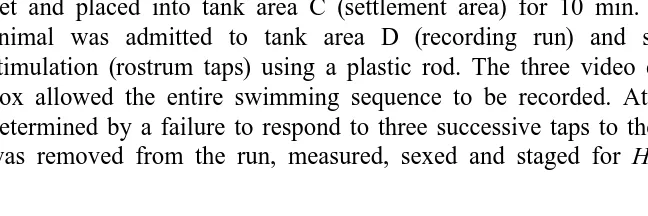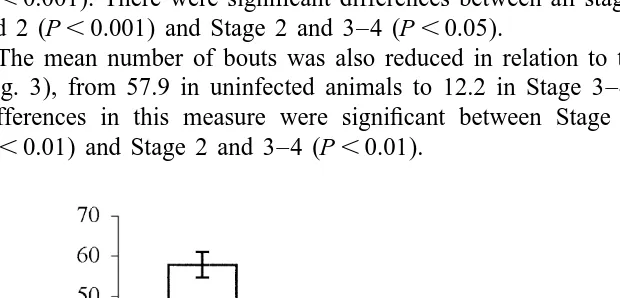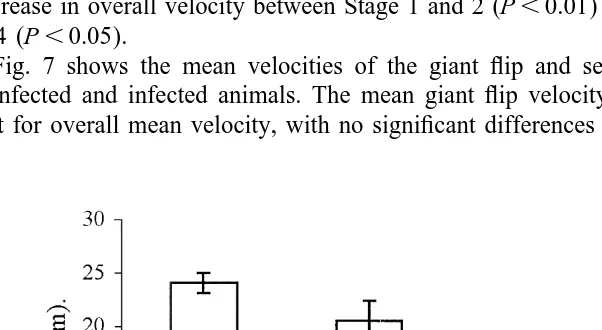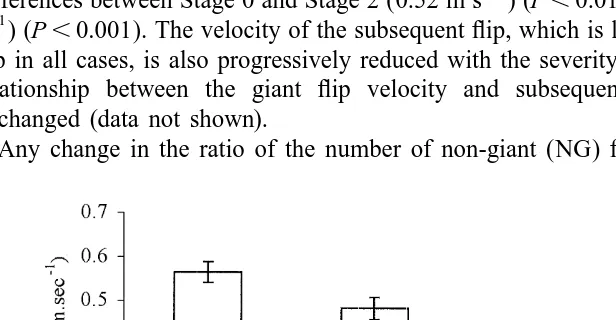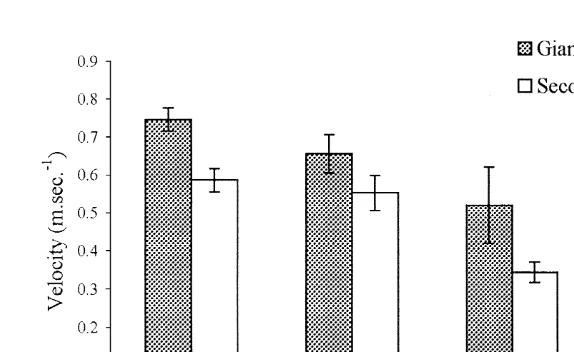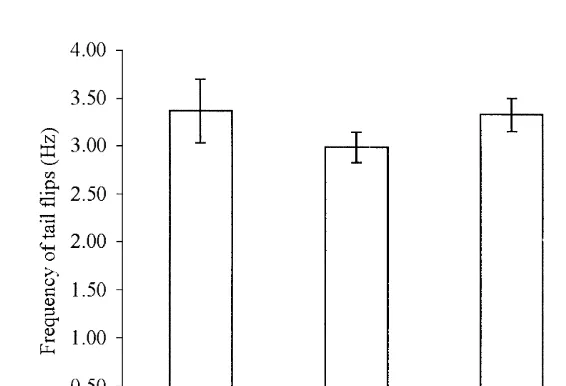L
Journal of Experimental Marine Biology and Ecology 247 (2000) 169–181
www.elsevier.nl / locate / jembe
An analysis of swimming performance in the Norway
lobster, Nephrops norvegicus L. infected by a parasitic
dinoflagellate of the genus Hematodinium
a ,* a b c
G.D. Stentiford , D.M. Neil , R.J.A. Atkinson , N. Bailey
a
Division of Environmental& Evolutionary Biology, University of Glasgow, Glasgow G12 8QQ, Scotland,
UK b
University Marine Biological Station Millport, Isle of Cumbrae KA28 0EG, Scotland, UK
c
Fisheries Research Services Aberdeen, PO Box 101, Victoria Road, Aberdeen AB11 9DB, Scotland, UK Received 1 November 1999; received in revised form 1 December 1999; accepted 12 December 1999
Abstract
Various components of swimming performance were measured in uninfected Norway lobsters (Nephrops norvegicus) and compared to animals at different stages of infection by a parasitic dinoflagellate (Hematodinium sp.). Animals showed a progressive decline in overall swimming performance as infection severity increased, with reductions in the number of tail-flips performed, the number of swimming bouts and the total distance travelled by swimming. The velocity of the first (giant-fibre mediated) tail flip and average velocity over the swimming bout were also significantly reduced in infected lobsters. Possible reasons for this decreased swimming per-formance are suggested and the implications of this for predator avoidance of infected lobsters in the benthic habitat, and for capture of Nephrops by trawl rigs are discussed. 2000 Elsevier Science B.V. All rights reserved.
Keywords: Nephrops; Tail flip; Hematodinium; Swimming; Escape reaction
1. Introduction
The Norway lobster Nephrops norvegicus, hereafter referred to by genus alone, like other species of lobster and like crayfish, can react to a visual or tactile stimulus by undertaking a series of ‘tail flips’ which propel the animal backwards through the water (Neil and Ansell, 1995). The main function of such a response is to remove the animal from a threatening situation, such as a predator. However, in the case of Nephrops, the
*Corresponding author.
response may facilitate avoidance of capture by trawlers (Newland and Chapman, 1989). The general ‘tail flip’ response of Nephrops has been well studied: upon abrupt mechanical stimulation of the rostrum or telson, Nephrops performs a series of tail flips, the first of which is preceded by giant fibre activity in the abdominal nerve cord (Newland and Neil, 1990a,b). This provides one of the best known examples of a stereotyped motor act (Newland et al., 1992). Such information has been used to show that the ability of Nephrops to evade trawler capture depends strongly on its ability to initiate a successful ‘tail flip’ response, although other factors such as its orientation to the trawl gear, proximity to the burrow and its ability to endure prolonged swimming are also important (Newland and Chapman, 1989).
Nephrops supports a major fishery in the United Kingdom, with the Scottish fishery contributing over 76% of this (£48 million in 1998 – FRS, 1999). Recently, stocks of Nephrops off the west coast of Scotland have been shown to harbour a seasonal infection by a parasitic dinoflagellate of the genus Hematodinium (Field et al., 1992) which is responsible for a disease syndrome resembling the ‘bitter crab disease’ (BCD) reported in Alaskan tanner crabs (Chionoecetes bairdi ) (Meyers et al., 1987, 1990) and also Hematodinium infections in other decapod hosts (Newman and Johnson, 1975; Wilhelm and Baulo, 1988; Latrouite et al., 1988; Shields, 1992; Hudson et al., 1993). Nephrops showing symptoms of patent infection are seen in catches taken in spring and early summer (Field and Appleton, 1995).
A number of studies have established the basic characteristics of Hematodinium-infection (Field et al., 1992), its progression, diagnosis and pathology (Field and Appleton, 1995, 1996) and its effect on host physiology (Taylor et al., 1996). It has been noted that the parasite partially invades the main flexor muscles of the abdomen (Field and Appleton, 1995), suggesting that there may be some reduction in its ability to produce tail flips, which could in turn lead to altered swimming performance during patent infection. Reduced swimming performance during infection may alter the ability of Nephrops to evade capture by trawlers and predators and thus has obvious commercial and ecological implications for affected populations. Resultant adjustment of catchability, expressed as fishing mortality (F) per unit of fishing effort (E) (i.e. F / E) also has implications for the quantitative assessment of populations exhibiting significant disease prevalence. The present study was therefore carried out to determine whether changes can be observed in the swimming performance of Nephrops when infected by Hematodinium. Data are discussed in relation to the capture of infected animals.
2. Methods
2.1. Collection and treatment of animals
Laboratory Aberdeen (MLA), Scotland, UK. Animals were fed ad libitum on squid (Loligo spp.) on arrival at MLA and again three days later. The carapace length of animals used was between 25 and 30 mm, to avoid known size-specific differences in swimming performance (Newland et al., 1988). Nephrops of both sexes were used as sex-specific differences in swimming performance are not seen unless the female is ovigerous (Newland et al., 1988). Animals were not fed for three days prior to the experiment to avoid any effects of differential feeding. All animals were in the intermoult state as defined by Aiken (1980).
2.2. Experimental set-up
Experiments designed to examine the effect of Hematodinium infection on various parameters of swimming performance were carried out in a 12 m dumbbell-shaped tank housed in the FBU of MLA (see Fig. 1). A frame carrying three video cameras (D , D1 2 and D ) (Panasonic WV-CL350) fitted with 6.5 mm auto-iris lenses was constructed3 along the length of tank area D (Fig. 1). A hand-held integrator switch (Primebridge PVS-1) allowed for switching between the different cameras, thereby keeping the animal in the field of view. The integrator output was linked to a time and date generator (Mitsibushi TDG-10B) before being recorded on a standard VHS video recorder. A distance marker (10 cm intervals) was placed along the length of tank area D and the tank was illuminated with standard halogen lighting fitted with dimmer switches.
2.3. Experimental protocol
Animals were housed in tank area B (Fig. 1) prior to being individually removed in a net and placed into tank area C (settlement area) for 10 min. After settlement, each animal was admitted to tank area D (recording run) and subjected to front-end stimulation (rostrum taps) using a plastic rod. The three video cameras and switching box allowed the entire swimming sequence to be recorded. At the end of a trial, as determined by a failure to respond to three successive taps to the rostrum, each animal was removed from the run, measured, sexed and staged for Hematodinium infection
using the pleopod staging method of Field and Appleton (1995). According to this method, Stage 0 denotes an apparently uninfected animal, with patent infection progressing from Stage 1 through to Stage 4. Stage 3 and 4 (heavily infected) animals were grouped in all analyses as animals in these groups show very similar disease characteristics (see Stentiford et al., 1999). A ‘bout’ of swimming is defined as the series of full flexions and extensions between tactile stimulation and rest and a ‘flip’ as one cycle of flexion and extension of the abdominal segments (Newland et al., 1988)
2.4. Video analysis
Recordings of Nephrops swimming performance (73 animals) were analyzed at the Division of Environmental and Evolutionary Biology at the University of Glasgow. The total number of tail flips, total number of bouts, number of flips per bout, total distance covered, overall swimming velocity, velocity of the giant and subsequent flip and flip frequency (Hz) were measured using a Panasonic AG-5700 VCR linked to a Panasonic AG-570 single-frame editing facility controller and a Panasonic WV-CM1000 colour monitor.
Measurements of tail-flip velocity and flip frequency were made on a total of 46 animals with different stages of Hematodinium infection. An acetate overlay was placed on the monitor screen and the position of the rostrum at the start position and at the initiation points of subsequent tail flips (tail extension following full flexion) were marked (see Arnott et al., 1998). The number of frames (20 ms) between each re-extension was recorded and the distance covered between marked points was calculated from the distance marker on the tank floor. Overall velocity was measured over one complete bout within the first three bouts of the swimming sequence and from this, the velocity of the first flip (giant-fibre mediated) and subsequent flip (non-giant fibre mediated) was calculated. Tail flip frequency (Hz) was calculated by dividing the number of flips in one bout by the time taken up to the initiation of the final flip of a given bout.
2.5. Data analysis
Comparisons of swimming parameters from uninfected and infected Nephrops were performed either by one-way analysis of variance (ANOVA) followed by between stage comparisons with a Tukey’s pairwise analysis (for normal distributed data), or by a Mann–Whitney test (for non-normal distributions). Tests were considered significant if P,0.05.
3. Results
Fig. 2. Mean total number of tail-flips performed over entire swimming sequence (6standard error) by infection stage. Stage 0 denotes uninfected animals, while Stage 1, 2 and 3–4 denote patent Hematodinium infection.
The mean number of flips performed by animals in response to the standard stimulus regime was reduced in relation to the severity of infection (Fig. 2). Uninfected animals flipped a mean of 140.2 times, with a reduction to 26.2 times in Stage 3–4 infection (P,0.001). There were significant differences between all stages of infection: Stage 1 and 2 (P,0.001) and Stage 2 and 3–4 (P,0.05).
The mean number of bouts was also reduced in relation to the severity of infection (Fig. 3), from 57.9 in uninfected animals to 12.2 in Stage 3–4 infection (P,0.001). Differences in this measure were significant between Stage 1 (43.9) and 2 (27.9) (P,0.01) and Stage 2 and 3–4 (P,0.01).
Fig. 3. Mean total number of swimming bouts performed over the entire swimming sequence (6standard error) by infection stage. Stage 0 denotes uninfected animals, while Stage 1, 2 and 3–4 denote patent
Owing to these similar trends, the number of flips per bout changed less, although 21
there was still a significant difference between uninfected (2.6 flips.bout ) and Stage 21
3–4 animals (1.8 flips.bout ) (P.0.05) and between Stage 1 animals (2.7 21
flips.bout ) and Stage 3–4 (P,0.05). The total distance travelled in the tail flip sequences also reduced with infection (Fig. 4), from 24.05 m in uninfected animals to 3.24 m in heavily infected (Stage 3–4) animals (P,0.001). The distance travelled was not significantly reduced in Stage 1 infection (20.56 m) when compared with uninfected animals (P50.065), but was significantly reduced in Stage 2 (10.13 m) (P,0.001) and in Stage 3–4 (3.24 m) (P,0.001). There was also a highly significant reduction in distance travelled between Stage 1 and 2 (P,0.001) and between Stage 2 and 3–4 (P,0.01).
Fig. 5 shows a typical bout velocity profile from an uninfected (Stage 0) and a heavily infected (Stage 3–4) Nephrops. From the start position, both animals reach peak velocity with the first (giant-fibre mediated) flip. This velocity is then maintained, albeit slightly reduced, until the final flip, following which the animal glides to rest (one bout).The bout duration and velocity profile of infected animals is almost identical to that of uninfected animals, but the flip velocity of both the giant and subsequent flips, is greatly reduced by the infection.
The overall mean velocity of a swimming bout (Fig. 6) was not significantly reduced
21 21
in Stage 1 infection (0.48 m s ) when compared with uninfected animals (0.56 m s )
21 21
(P.0.05). However, in Stage 2 (0.35 m s ) and 3–4 (0.24 m s ), overall velocity of the bout was reduced significantly (both P,0.001). There was also a significant decrease in overall velocity between Stage 1 and 2 (P,0.01) and between Stage 2 and 3–4 (P,0.05).
Fig. 7 shows the mean velocities of the giant flip and second (non-giant) flip for uninfected and infected animals. The mean giant flip velocity shows similar trends to that for overall mean velocity, with no significant differences between Stage 1 velocity
Fig. 5. Typical bout velocity profile for an uninfected (Stage 0) and heavily infected (Stage 3–4) Nephrops. Key: S (start point – zero velocity), S to G (point of tail extension at end of giant flip), G to 1 (tail extension
nd rd
at end of flip following giant flip), 1 to 2 (tail extension of 2 flip after giant), 2 to 3 (tail extension of 3 flip
th
after giant), 3 to 4 (tail extension of 4 flip after giant), 41Glide (velocity of glide following fourth flip after giant).
21 21
(0.66 m s ) and Stage 0 velocity (0.75 m s ) (P.0.05) but highly significant 21
differences between Stage 0 and Stage 2 (0.52 m s ) (P,0.01) and Stage 3–4 (0.32 m 21
s ) (P,0.001). The velocity of the subsequent flip, which is less than that of the giant flip in all cases, is also progressively reduced with the severity of infection, so that the relationship between the giant flip velocity and subsequent flip velocity remains unchanged (data not shown).
Any change in the ratio of the number of non-giant (NG) flips to giant (G) flips is
21
21
Fig. 7. Mean giant tail-flip and second tail-flip velocity comparisons (m s ) (6standard error) by infection stage. Stage 0 denotes uninfected animals, while Stage 1, 2 and 3–4 denote patent Hematodinium infection.
likely to influence the overall velocity (Fig. 6) since the NG velocity has been shown to be less than that of G flip velocity (Fig. 7). However, the number of NG flips per bout is not significantly different, even in heavily infected animals (1.76 versus 1.59 in uninfected animals)(P.0.05).
The frequency of tail flips measures the rate at which repeated full tail flexions can be performed. When single bouts were analyzed, flip frequency was approximately 3 Hz in all stages of infection (Fig. 8) and no significant differences in flip frequency (Hz) were found between uninfected and infected Nephrops.
4. Discussion
4.1. Swimming performance in relation to hematodinium infection
The mean swimming speed of uninfected Nephrops measured in the present study 21
Fig. 8. Mean tail flip frequency (Hz) over a swimming bout (6standard error) by infection stage. Stage 0 denotes uninfected animals, while Stage 1, 2 and 3–4 denote patent Hematodinium infection.
frequency, which suggests that the neuronal circuitry controlling both giant fibre activation and non-giant pattern generation is unaffected by the infection.
An alteration in normal muscle contraction could arise as a consequence of the parasite-induced damage of muscle fibres, as described by Field et al. (1992) and Field and Appleton (1995), with parasites penetrating the fibre interstices in late infection (Stages 3 and 4) and possibly lysing the peripheral regions of the fibres. A reduced swimming performance would be expected as a result of such loss of contractile machinery, since giant-fibre mediated tail flipping maximally excites these muscles, causing them to operate close to their maximum isometric condition, with little or no reserve capacity. Muscle damage of a similar nature has also been reported as a symptom of Hematodinium-infections of other decapods (Meyers et al., 1987; Hudson and Shields, 1994; Wilhelm and Mialhe, 1996). Muscle fibre damage could also affect the rate of muscle contraction by disrupting the steps in excitation–contraction coupling. Although tail-flip frequency remained unchanged in infection, no separate measures of flexion duration were made, and therefore it cannot be excluded that a decrease in the contraction rate of abdominal flexor muscles also contributed to the decrease in propulsive swimming thrusts. Combined measurements of the movements of the abdomen during tail flipping and the propulsive forces that are produced, as performed in the studies of Newland and Neil (1990a,b) and Baden and Neil (1998), are required to resolve these issues.
partial exhaustion, which would restrict their capacity to respond to the increased respiratory demands of swimming.
Elevated levels of muscle and plasmaL-lactate are also known to cause a cessation of
tail flipping in spiny lobsters (Vermeer, 1987), and in Nephrops, recovery of full swimming ability is linked to recovery of near normal haemolymph L-lactate
con-centrations (Field et al., 1991; Newland et al., 1992). Heavily infected Nephrops have considerably elevated plasmaL-lactate concentrations (Taylor et al., 1996), but
apparent-ly unaltered muscle L-lactate concentrations (Field, 1992), and it is therefore possible
that this increased plasmaL-lactate is a factor in reducing the swimming endurance of
infected animals. Depletion of the metabolic reserves used for active swimming may also play a part in the reduced swimming endurance during Hematodinium infection. Although the concentration and re-synthesis of ATP in abdominal muscle appear not to limit escape swimming endurance in uninfected Nephrops (Field et al., 1991) in the manner reported for the scallop (Grieshaber, 1978), it is possible that the reduced muscle glycogen concentrations measured during Hematodinium infection (unpublished ob-servations) cause a shortfall in the re-supply of ATP to the contractile machinery, thereby degrading swimming performance.
The observed decline in the number of tail flips performed by Nephrops infected by Hematodinium is consistent with an increased rate of habituation in the giant fibre systems. Habituation of giant-fibre systems is a common feature of tail flip swimming in many crustacean species (Neil and Ansell, 1995; Arnott et al., 1998; reviewed by Edwards et al., 1999) including Nephrops (Newland et al., 1988), and is known to be mediated by the neurotransmitter GABA (Krasne and Roberts, 1967; Vu and Krasne, 1993; Krasne and Teshiba, 1995). One observation that may link Hematodinium infection to an alteration in the action of a neuronal pathway for habituation mediated by GABA is that free amino acid concentrations in the plasma of Nephrops are changed during infection (Stentiford et al., 1999). Of these changes, an approximately 12-fold increase in the circulating taurine concentration is the most significant, and since taurine is known to have a neuromodulatory action (Oja and Kontro, 1978; Kuriyama et al., 1978), and in crustaceans is known to mimic the inhibitory actions of GABA (Zatta, 1987; Payen et al., 1981), it may contribute to a greater suppression of repeated giant fibre activation, and thus the reduction of tail flipping.
4.2. Reduced swimming performance in relation to trawl capture
Commercial Nephrops trawls are normally towed at speeds of between 1 and 1.6 m 21
stages of infection reduces their vulnerability to capture. The use of creel sampling for Hematodinium-infection assessment has shown that infected animals are rarely found within the creels (Pers.Obs. Dr. R.J.A. Atkinson). However, in the Clyde sea area, only shallow waters (with larger Nephrops) can be fished with creels, while the deeper grounds, which tend to contain Nephrops within the size range commonly infected by Hematodinium (30–35 mm carapace) are fished by trawlers. As a result, a direct comparison of trawl and creel prevalence (see Wilhelm and Mialhe, 1996) would be misleading. However, both the present work and other studies of Nephrops swimming performance (Newland et al., 1992), suggest that infected animals are more likely to be captured by standard Nephrops trawling rigs than their non-infected counterparts. Thus, the prevalence of Hematodinium reported for sites off the west coast of Scotland (Field et al., 1998) may be an overestimate of the true level of infection in these populations. The same decrease in swimming performance may also make infected animals more prone to predation, causing further imbalance in proportions of uninfected and infected animals.
Early attempts to incorporate the high observed prevalence of Hematodinium infection into analytical stock assessments of the Clyde sea area (ICES, 1997), modeled the effect as an additional loading on the natural mortality rate (since animals showing symptoms of patent infection usually die). However, the exercise was not entirely successful, leading, as it did, to unrealistic estimates of recruits entering the fishery. The observations above suggest that a more subtle approach is necessary when examining the effect of the disease on the population. Reduced swimming performance implies increased catchability (F / E); in other words, a given unit of fishing effort would result in a higher increased mortality rate in populations with high prevalence of the disease. Furthermore, if infected animals are likely to be more susceptible to predation through reduced ability to escape, then the disease may not necessarily add to overall natural mortality but rather, replace a proportion of it.
Acknowledgements
This work was supported by a contract from the Ministry of Agriculture Fisheries & Food of the United Kingdom (Contract No. CSA 4172, Project code MFO221). The authors wish to thank Mr Mick Parker and the crew of the RV ‘Aora’ (University Marine Biological Station Millport) for assistance in collection and sorting of animals, Mr Adrian Weetman and Mr David Bova at Marine Laboratory Aberdeen (MLA) for much assistance in tank set up and Mr Ben Williamson and the staff of the Fish Behaviour Unit at MLA for assistance with animal husbandry. [SS]
References
Arnott, S.A., Neil, D.M., Ansell, A.D., 1998. Tail-flip mechanism and size-dependent kinematics of escape swimming in the brown shrimp Crangon crangon. J. Exp. Biol. 201, 1771–1784.
Baden, S.P., Neil, D.M., 1998. Accumulation of manganese in the haemolymph, nerve and muscle tissue of
Nephrops norvegicus (L.) and its effect on neuromuscular performance. Comp. Biochem. Physiol. 119A,
351–359.
Edwards, D.H., Heitler, W.J., Krasne, F.B., 1999. Fifty years of a command neuron: the neurobiology of escape behaviour in the crayfish. Trends Neurosci. 22, 153–161.
Field, R.H., Appleton, P.L., 1995. A Hematodinium-like dinoflagellate infection of the Norway lobster
Nephrops norvegicus: observations on pathology and progression of infection. Dis. Aquat. Org. 22,
115–128.
Field, R.H., Appleton, P.L., 1996. An indirect fluorescent antibody technique for the diagnosis of
Hemato-dinium sp. infection of the Norway lobster, Nephrops norvegicus. Dis. Aquat. Org. 24, 199–204.
Field, R.H., Chapman, C.J., Taylor, A.C., Neil, D.M., Vickerman, K., 1992. Infection of the Norway lobster
Nephrops norvegicus by a Hematodinium-like species of dinoflagellate on the west coast of Scotland. Dis.
Aquat. Org. 13, 1–15.
Field, R.H., 1992. The control of escape behaviour in, and the histopathology of, the Norway lobster,
Nephrops norvegicus (L.). PhD Thesis, University of Glasgow.
Field, R.H., Hills, J.M., Atkinson, R.J.A., Magill, S., Shanks, A.M., 1998. Distribution and seasonal prevalence of Hematodinium sp. infection of the Norway lobster (Nephrops norvegicus) around the west coast of Scotland. ICES J. Mar. Sci. 55, 846–858.
Field, R.H., Taylor, A.C., Neil, D.M., 1991. Factors affecting swimming ability and its recovery in the Norway lobster (Nephrops norvegicus). J. Mar. Biol. Ass. UK 71, 707–742.
FRS, 1999. Nephrops stocks around Scotland. Fisheries Research Service (FRS) fish stocks information leaflet; December 1999.
Grieshaber, M., 1978. Breakdown and formation of high energy phosphates and octopine in the adductor muscle of the scallop, Chlamys opercularis (L.) during escape swimming and recovery. J. Comp. Physiol. 126, 269–276.
Hudson, D.A., Shields, J.D., 1994. Hematodinium australis n. sp., a parasitic dinoflagellate of the sand crab
Portunus pelagicus from Moreton bay. Australia. Dis. Aquat. Org. 19, 109–119.
Hudson, D.A., Hudson, N.B., Shields, J.D., 1993. Infection of Trapezia spp. (Decapoda: Xanthidae) by
Hematodinium sp. (Duboscquodinida: Syndinidae): a new family record. J. Fish Dis. 16, 273–276.
ICES, 1997. Report of the working group on Nephrops stocks. ICES CM 1997 /Assess: 9
Krasne, F.B., Teshiba, T.M., 1995. Habituation of an invertebrate escape reflex due to modulation by higher centres rather than local events. Proc. Natl. Acad. Sci. USA 92, 3362–3366.
Krasne, F.B., Roberts, A., 1967. Habituation of the crayfish escape response during release from inhibition induced by picrotoxin. Nature 215, 769–770.
Kuriyama, K., Muramatsu, M., Nakagawa, K., Kakita, K., 1978. Modulating role of taurine on release of neurotransmitters and calcium transport in excitable tissues. In: Barbeau, A., Huxtable, R.J. (Eds.), Taurine and Neurological disorders, Raven Press, New York, pp. 201–216.
¨
Latrouite, D., Morizur, Y., Noel, P., Chagot, D., Wilhelm, G., 1988. Mortalite du tourteau Cancer pagurus provoquee par le dinoflagelle parasite: Hematodinium sp. In: ICES Committee Meeting, p. CM.1988 / K:32. Meyers, T.R., Bothelo, C., Koeneman, T.M., Short, S., Imamura, K., 1990. Distribution of bitter crab dinoflagellate syndrome in southeast Alaskan tanner crabs Chionoecetes bairdi.. Dis. Aquat. Org. 9, 37–43. Meyers, T.R., Koeneman, T.M., Bothelo, C., Short, S., 1987. Bitter crab disease: a fatal dinoflagellate infection
and marketing problem for Alaskan tanner crabs, Chionoecetes bairdi. Dis. Aquat. Org. 3, 195–216. Neil, D.M., Ansell, A.D., 1995. The orientation of tail-flip escape swimming in decapod and mysid
crustaceans. J. Mar. Biol. Ass. UK 75, 55–70.
Newland, P.L., Chapman, C.J., 1989. The swimming and orientation behaviour of the Norway lobster,
Nephrops norvegicus (L.), in relation to trawling. Fish. Res. 8, 63–80.
Newland, P.L., Neil, D.M., 1990a. The tail flip of the Norway lobster, Nephrops norvegicus I. Giant fibre activation in relation to swimming trajectories. J. Comp. Physiol. A 166, 517–527.
Newland, P.L., Chapman, C.J., Neil, D.M., 1988. Swimming performance and endurance of the Norway lobster
Nephrops norvegicus. Mar. Biol. 98, 345–350.
Newland, P.L., Neil, D.M., Chapman, C.J., 1992. Escape swimming in the Norway Lobster. J. Crust. Biol. 12, 342–353.
Newman, M.W., Johnson, C.A., 1975. A disease of blue crabs (Callinectes sapidus) caused by a parasitic dinoflagellate, Hematodinium sp. J. Parasitol. 64, 158–160.
Oja, S.S., Kontro, P., 1978. Neurotransmitter actions of taurine in the central nervous system. In: Barbeau, A., Huxtable, R.J. (Eds.), Taurine and Neurological disorders, Raven Press, New York, pp. 181–200. Payen, G.G., Pochon-Masson, J., Portemer, C., Chattanger, F., 1981. Effects of eyestalk ablation on the
concentration of taurine in various organs of the shore crab Carcinus maenas (L.) (Decapoda: Brachyura). Comp. Biochem. Physiol. 69A, 571–574.
Shields, J.D., 1992. Parasites and symbionts of the crab Portunus pelagicus from Moreton bay, eastern Australia. J. Crust. Biol. 12, 94–100.
Stentiford, G.D., Neil, D.M., Coombs, G.H., 1999. Changes in the plasma free amino acid profile of the Norway lobster, Nephrops norvegicus at different stages of infection by the parasitic dinoflagellate (genus
Hematodinium). Dis. Aquat. Org. 38, 151–157.
Taylor, A.C., Field, R.H., Parslow-Williams, P.J., 1996. The effects of Hematodinium sp.-infection on aspects of the respiratory physiology of the Norway Lobster, Nephrops norvegicus (L.). J. Exp. Mar. Biol. Ecol. 207, 217–228.
Vermeer, G.K., 1987. Effects of air exposure on desiccation rate, haemolymph chemistry, and escape behaviour of the spiny lobster, Palinurus argus. Fish. Bull. US 85, 45–51.
Vu, E.T., Krasne, F.B., 1993. Crayfish tonic inhibition: prolonged modulation of behavioural excitability by classical GABAergic inhibition. J. Neurosci. 13, 4394–4402.
Wilhelm, G., Boulo, V., 1988. Infection de l’etrille Liocarcinus puber (L.) par un dinoflagelle parasite de type
Hematodinium. In: ICES Committee Meeting, p. CM.1988 / K:32.
Wilhelm, G., Mialhe, E., 1996. Dinoflagellate infection associated with the decline of Necora puber crab populations in France. Dis. Aquat. Org. 26, 213–219.
